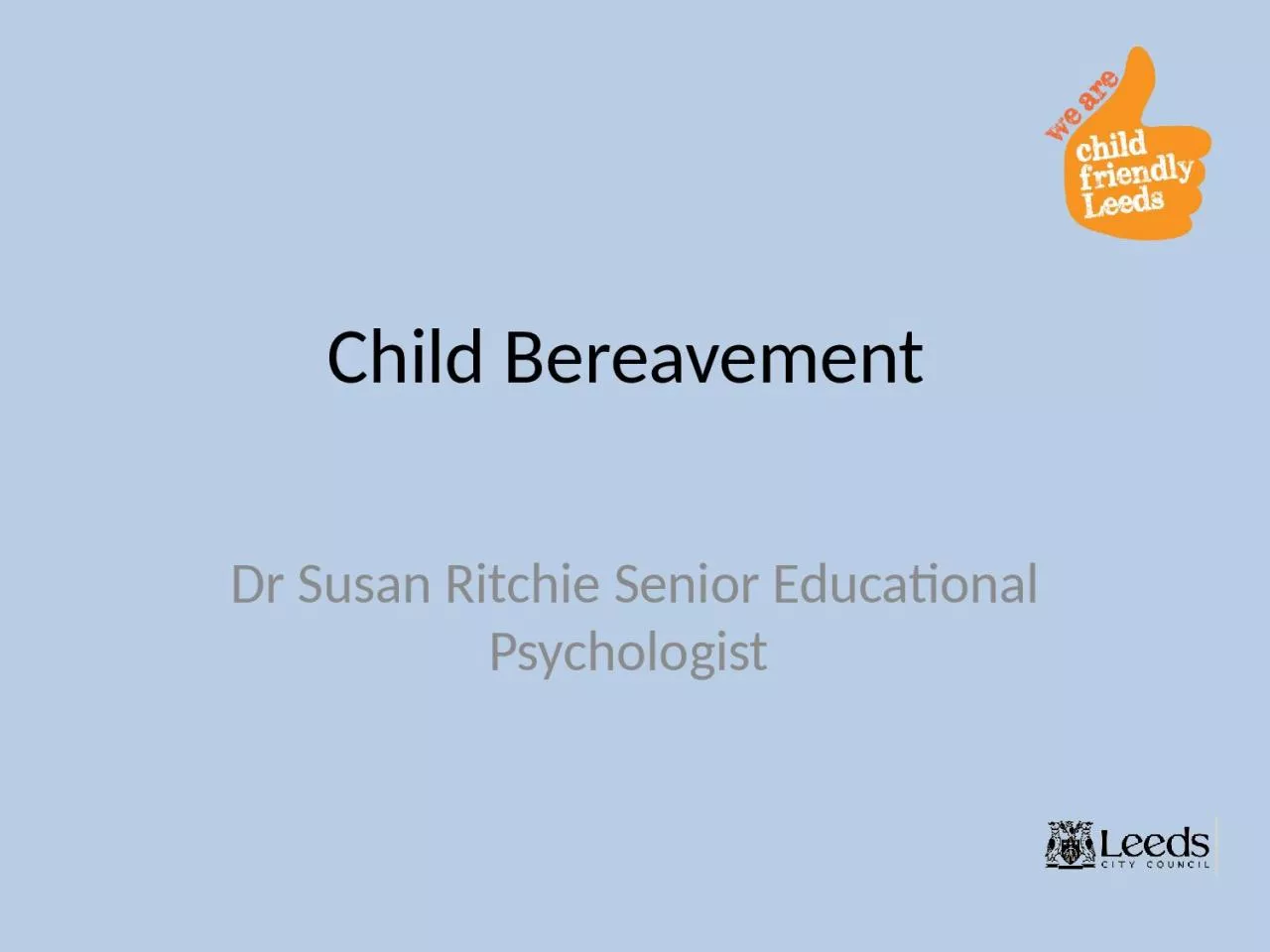

Bereavement Death affects us all Yet it is still the last taboo in our society and grief is still profoundly misunderstood Julia Samuel Bereavement in Children How children and young people cope with grieving is mediated by risk and resilience factors ID: 935032
Download Presentation The PPT/PDF document "Child Bereavement Dr Susan Ritchie Seni..." is the property of its rightful owner. Permission is granted to download and print the materials on this web site for personal, non-commercial use only, and to display it on your personal computer provided you do not modify the materials and that you retain all copyright notices contained in the materials. By downloading content from our website, you accept the terms of this agreement.
Slide1
Child Bereavement
Dr Susan Ritchie Senior Educational Psychologist
Slide2Bereavement
‘Death affects us all. Yet it is still the last taboo in our society, and grief is still profoundly misunderstood…..’
Julia Samuel
Slide3Bereavement in
Children
How children and young people cope with grieving is mediated by risk and resilience factors. Risk – socio-economic disadvantage, lack of connectedness to school and community, difficulties within the family.
Resilience – is affected by personal traits but also importantly by environmental protective factors, from home school and community.
Slide4“
A sense of connectedness to parents and school is the most significant protective factor for young people.”
Resnick
et al (1997)
Slide5Cultural
Context
Every culture has a specific approach or response to grief and loss; the specific cultural beliefs, values, expressions, expectations, ceremonies and rituals give meaning to loss in different ways
Hoonyman
& Kramer (2006)
Slide6Theories
Elisabeth
Kubler Ross (1973) Stage theory of griefDenial
Anger
Bargaining
Depression Acceptance
Slide7Theories of
Grief
William Worden – tasks of grieving To accept the reality of loss
To work through the pain of grief
Adjust to an environment in which the deceased is missing
Emotionally relocate the deceased and move on with life
Slide8Understanding what death means and the confusion caused by euphemisms
Universality – death happens to all living things
Irreversibility – its permanent, the body cannot be made alive again.
Non-functionality –
breathing,
eating, sleeping, thinking cease.
Causality – an understanding that external or internal factors have caused the death.
Slide9Children 0 – 2 years
Young children will not
understand, will not have the language to express their feelings, but they will have feelings. Children this age will be affected by the emotional state of the other important people in their
lives.
How to help - love
,
routine, emotional containment and
care. As
they get older they will need help to build a story and to know the deceased person as part of their history.
Slide10Children aged 2 - 5
Children this age are likely to think death is reversible, may ask the same questions repeatedly to help them
understand. They may have have ‘magical thinking’ – that they caused the death or can wish the person back to life.
The
child’s
behaviour may regress,
or become fearful when separated from loved ones.How to help - Answering
questions simply and factually, being tolerant of behaviour regression, reading books drawing pictures.
Slide11Children aged 6-9
Children at this age are very imaginative and may be scared of death.
They are beginning to have an understanding of what death means but may also have a lot of curiosity about what happens to a dead body.
Children
may have physical symptoms but find it hard to express their feelings verbally. This can lead to them expressing their feelings as behaviour or becoming withdrawn
.
How to help – model how to express feelings, using activities, e.g. memory boxes to remember and talk, answering questions truthfully but simply.
Slide12Children aged 9 -13
They are beginning to understand the finality of death and know the impact that death has had on them.
At a time of wanting to fit in with their peers the death of a significant loved one can make them feel different.
How to help – maintain routines, allow regression, look for opportunities for them to share feelings with others, engage in activities, e.g. memory boxes or photo albums.
Slide13Adolescence
A natural time of transition and change, a moving away from adults and peers becoming more important.
Sadness, withdrawal, lonelinessMood changes, low moodsAct out anger
Reject adults, reluctant to talk
May
regress
High risk activities
What may help – give comfort, take feelings seriously, include in planning, encourage time with friends, offer opportunities to speak.
Slide14Activities which can help
Slide15Resources which can help
Slide16Slide17Where to find help
Leeds Pathway for Children and Young People who have been Bereaved Children and Bereavement pathway -
Early Start Team Bereavement Pathway SAD Events Team Seasons for Growth